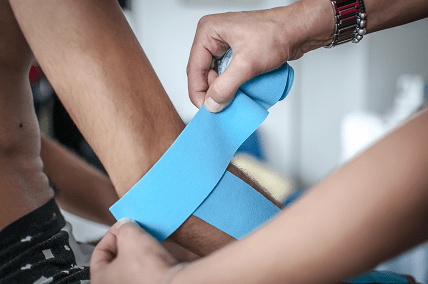
Overview
A distal biceps tendon rupture refers to a complete tear of the biceps tendon at the elbow. It typically occurs in 30-50 year-old males when trying to perform an elbow contraction such as an arm curl, or a lifting, throwing or catching activity that is too heavy or too overloaded.
Distal biceps tendon ruptures occur suddenly, with associated:
- Popping, snapping or giving way of the elbow.
- Immediate pain at the elbow.
- Immediate weakness of the elbow.
- Muscle bunching and deformity of the upper arm (popeye deformity).
Following a distal biceps tendon rupture, the biceps muscle shortens, leaving a disfigured bunched-up muscle in the upper arm. This disfigurement is sometimes described as popeye deformity, although true popeye deformity is the result of tearing a biceps tendon at the shoulder rather than the elbow. A ruptured tendon cannot heal by itself and will need surgery to be repaired.
If you have suffered a distal biceps tendon rupture, you only have a short amount of time before extensive muscle shortening occurs and the biceps tendon becomes increasingly difficult to surgically repair. If your tendon cannot be retrieved, you may be left with upper arm deformity and weakness of the elbow permanently. If you suspect you may have a biceps injury, it’s important you get it seen quickly.

Symptoms
Distal biceps tendon rupture may have the following symptoms:
- Deformity of the biceps muscle.
- Bruising at the front of the elbow.
- Swelling at the front of the elbow.
- A gap in the elbow where the tendon used to be.
- Weakness when bending the elbow.
- Weakness when pronating the forearm (an action like turning a screwdriver).
Causes
Distal biceps tendon rupture occurs when forcefully straightening a contracting elbow, typically in 35-50 year old males. This movement occurs when lowering something heavy, or grabbing something to slow you down as you are running by. Throwing or catching large heavy objects or playing with small children are the type of activities that can lead to biceps rupture. Males who are older than 30, who smoke and who may be using corticosteroids are most at risk of sustaining a distal biceps tendon rupture.
Sports injuries can also be the cause of biceps tears. For example, the famous sport is known as the “Caber Toss”, where a large heavy log is thrown in competition is well known to cause bicep rupture at the elbow. The rupture occurs at the point just prior to throwing the log where the competitor straightens the elbow against the resistance of the log in order to throw it. If the log is too heavy, a sudden rupture of the distal biceps tendon may occur.
It is common for workplace injuries to cause biceps tears. Catching large heavy objects when they fall is a common cause of distal biceps tendon ruptures at work. A reaction to catching a box falling from a table or conveyor belt, playing with children or catching a child who may be about to run into traffic, or someone dropping an unexpectedly heavy item into a bag you may be carrying may cause sudden biceps tendon rupture at the elbow.

Diagnosis
Diagnosing a biceps tendon tear/rupture at the elbow is a multi-step procedure and the following will be taken into consideration:
- Understand the nature of the injury (sports, work, accident, overuse etc).
- Determine the cause of the injury (impact, collision, fall, repetitive/slow onset).
- Understand the context of the suffering (age, return to sport, work, impact on daily living).
- Perform a physical examination to ascertain pain and range of movement.
- Perform specialised elbow tests to confirm diagnosis.
Complete Rupture at the Elbow
Complete distal biceps rupture tears are obvious as you will see a clear muscle bunching deformity in the upper arm. The finger hook test is a specific physical examination used to confirm the attachment of the biceps tendon at the elbow. If the tendon attachment is ruptured, a hook cannot be performed and rather a gap will be felt instead. A comparison to the patient’s non-affected side is always useful to determine the patient’s sense of normal.
Imaging such as xray and MRI and further diagnostic tests are used to determine whether there are any fractures contributing to the condition and to determine if the biceps tendon has started to retract up the upper arm away from the elbow. Early diagnosis and treatment of biceps injury are extremely important to avoid the risk of a permanent injury.

Treatment
Treatment of biceps tendon rupture at the elbow should always begin with a thorough diagnosis of your condition to understand the severity of the condition in the context of your age and how your elbow function may impact your job, or sport, and life.
Surgical Treatment
Surgical treatment for ruptures is advisable if you wish to regain normal function of your elbow and wrist to minimise the deformity of the upper arm. Early treatment of biceps tendon rupture at the elbow is extremely important to minimise the possibility of retracted biceps tendon which makes repairing the condition difficult. Surgical repair involves retrieving the retracted biceps tendon from the upper arm and re-attaching it to the forearm at the elbow.

Post Operative Rehabilitation
You will achieve the best surgical outcome if you follow up surgery with a matching course of rehabilitation. Following surgery, Dr Gupta will outline the most appropriate rehabilitation protocol for your physiotherapist to follow and communicate with your healthcare team to ensure that you receive the best post-operative treatment.
Please contact our friendly team on 02 9687 8344 or make an online enquiry here.

Dr Manish Gupta | MBBS FRACS FAOrthoA
Dr Manish Gupta is a renowned expert surgeon in the field of orthopaedic surgery specialising in upper limb including shoulder, elbow and wrist.